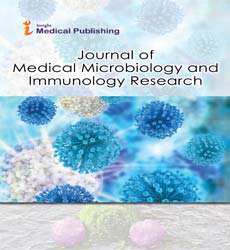ISSN : 2634-7164
Journal of Medical Microbiology and Immunology Research
Biology and natural history of human papillomavirus infection
Abstract
Human papillomavirus (HPV) is one of the most common causes of sexually transmitted diseases worldwide. It has been proposed that the great majority of women and men have been infected with HPV at least once during their lifetime. HPV infection is associated with a variety of clinical conditions, ranging from benign lesions to cervical cancer. In most cases, the infection is transient, where most of the individuals are healing, eliminating the virus without the presence of any clinical manifestation. Actually, more than 120 HPV types have been cataloged, of which approximately 40 can infect the mucosa of the anogenital tract and are collectively known as mucosal HPV, which are classified based on their oncogenic potential as either low- or high-risk HPV types. The low-risk HPV type causes benign hyperproliferative lesions or genital warts, with a very limited tendency for malignant progression, while the high-risk HPV type is strongly associated with premalignant and malignant cervical lesions. The HPV cycle initiates when the virus gains access to undifferentiated cells of the basement membrane of the squamous columnar junction epithelium of the ectocervix, after these regions are exposed to mechanical or chemical trauma. The basal cells in the transformation zone retain the ability to differentiate, a property required for virion production. Cervical infection with high-risk HPV typically lasts from 12 to 18 months and in most cases is cleared spontaneously. However, in some women the immune response is insufficient to eliminate the virus, resulting in a persistent, long-term infection that may progress to a malignant lesion. In this review, we discuss the biology and natural history of HPV infection and its association with cervical cancer
Open Access Journals
- Aquaculture & Veterinary Science
- Chemistry & Chemical Sciences
- Clinical Sciences
- Engineering
- General Science
- Genetics & Molecular Biology
- Health Care & Nursing
- Immunology & Microbiology
- Materials Science
- Mathematics & Physics
- Medical Sciences
- Neurology & Psychiatry
- Oncology & Cancer Science
- Pharmaceutical Sciences
